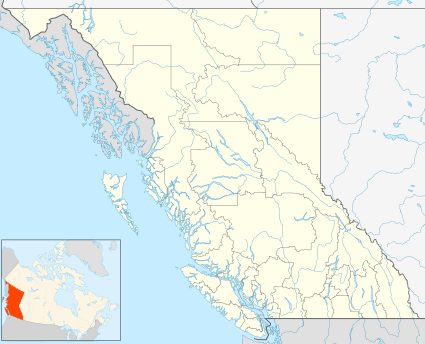Leechtown, British Columbia
Leechtown is a ghost town on Vancouver Island in British Columbia, Canada.
Leechtown | |
|---|---|
 Leechtown Location of Leechtown in British Columbia | |
| Coordinates: 48°29′00″N 123°43′00″W | |
| Country | |
| Province | |
Location
The site now is only a clearing in the forest with little remaining except for some rotting foundations. It was accessible by bike or foot on the Galloping Goose Trail which follows a portion of the former Canadian National rail line between Victoria and the town of Youbou on the north shore of Cowichan Lake. The site of the Gold Commissioner's house is marked by a cairn on the north-western side of the Leech River at 48°29.741′N 123°42.705′W. The current stone cairn is a replica cairn erected by concerned businessmen after the original cairn was destroyed by vandals. The original cairn's bronze dedication plate has been stolen but it used to read:
Memorial erected by the B.C. Historical Association on site of gold commissioner’s house to commemorate discovery of gold on Sooke River by Lieut. P. Leech, July, 1864, and to mark the site of Leechtown, which sprang up following discovery. Unveiled by the HON. R.BRUCE LIEUT.-GOVERNOR OF B.C. SEPT. 15. 1928
History
The town was named after Lieutenant Peter John Leech of the Royal Engineers and astronomer of the Vancouver Island Exploring Expedition who was later City Engineer for Victoria, British Columbia. The Expedition, led by Robert Brown, discovered gold on the Leech River in July 1864.[1][2]:303 Within weeks, thousands of miners, many of whom were veterans of the Fraser Canyon Gold Rush six years earlier, travelled from Victoria overland by trail or by steamer to Sooke. By August 14 of that year, 227 mining licences had been issued and by the end of the year there were 6 general stores and 3 hotels in business along with 30 saloons. At its peak, Leechtown and neighbouring Boulder City had 1,200 mines and 4,000 people, but by 1865, the area went into decline. As much as $100,000 in gold may have been taken out in the first year by a single miner, Donny Roux.[3]
Geology
Leechtown is notable for its geologic placement, which is what gives rise to the historical gold finds. The Leech River runs along the Leech River Fault, a major regional fault that marks a distinct geological boundary between the Pacific Rim Terrane and the Crescent Terrane (part of Siletzia).[4] The "Leech River Complex" (also "Leech River Formation" and "Leech River Schist") is a well-known assemblage of highly deformed schists underlain by gneiss. The gold is thought to be derived from quartz stringers concentrated in the schists, emplaced by hydrothermal events related to the regional tectonic activity.
Current status
The area around Leechtown is still actively under placer claim, almost a century and a half after its discovery and still produces quantities of fine gold and flakes up to 0.25". In 2007 the area was purchased for the Greater Victoria water supply[5] which will protect it from development and prevent public access. Although maps show Leechtown as being the end of the Galloping Goose Trail, since 2010 a warning sign and locked gate have greeted hikers before the end of the trail. Thus Leechtown is no longer accessible from the Galloping Goose Trail.
Folklore
Local legends report that a tunnel exists in Leechtown that has been chiseled out of the rock, with multiple galleries. The Colonist newspaper planned to fund an expedition in search of the lost tunnel in 1959, but the only person with knowledge of its location, Ed Mullard, died before the search could take place.[6]
The Mullard Tunnel is located in Jordan Meadows, approximately 10 km (6 mi) away and there have been several stories of the discovery of the tunnel. Mullard was in the Jordan Meadows area prospecting and went deer hunting one afternoon and stumbled upon the tunnel entrance. A logger supposedly discovered the tunnel in 1928 and ended up in Las Vegas with some of the gold. There was supposedly a gold bar from the tunnel on display at the Mineral Titles office in Victoria, BC until the early 1980s but no one knows the location of the gold bar now.
References
- Hudson, Richard (1997). A field guide to gold, gemstone, and mineral sites of British Columbia. Victoria, BC: Orca Book Publishers. p. 79. ISBN 1-55143-057-6..
- Walbran, Captain John T. (1971). British Columbia Place Names, Their Origin and History (Facsimile reprint of 1909 ed.). Vancouver/Toronto: Douglas & McIntyre. ISBN 0-88894-143-9. Archived from the original on 2016-03-03. Retrieved 2009-04-26.
- Paterson, TW (1989). Ghost Towns and Mining Camps of Vancouver Island. Langley, BC: Sunfire Publications. p. 2. ISBN 0-919531-29-6.
- Natural Resources Canada:Geoscape Victoria Archived 2008-06-24 at the Wayback Machine
- "9,700-hectare land purchase protects future drinking water supply for CRD residents, and adds to regional park system". PR Newswire. Archived from the original on 2007-09-29. Retrieved 2008-01-02.
- Victoria Daily Times. Victoria, British Columbia. September 21, 1969. Missing or empty
|title=(help)